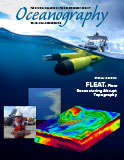Article Abstract
Palau, an island group in the tropical western North Pacific at the southern end of Kyushu-Palau Ridge, sits near the boundary between the westward-flowing North Equatorial Current (NEC) and the eastward-flowing North Equatorial Countercurrent. Combining remote-sensing observations of the sea surface with an unprecedented in situ set of subsurface measurements, we examine the flow near Palau with a particular focus on the abyssal circulation and on the deep expression of mesoscale eddies in the region. We find that the deep currents time-averaged over 10 months are generally very weak north of Palau and not aligned with the NEC in the upper ocean. This weak abyssal flow is punctuated by the passing of mesoscale eddies, evident as sea surface height anomalies, that disrupt the mean flow from the surface to the seafloor. Eddy influence is observed to depths exceeding 4,200 m. These deep-reaching mesoscale eddies typically propagate westward past Palau, and as they do, any associated deep flows must contend with the topography of the Kyushu-Palau Ridge. This interaction leads to vertical structure far below the main thermocline. Observations examined here for one particularly strong and well-sampled eddy suggest that the flow was equivalent barotropic in the far field east and west of the ridge, with a more complicated vertical structure in the immediate vicinity of the ridge by the tip of Velasco Reef.

